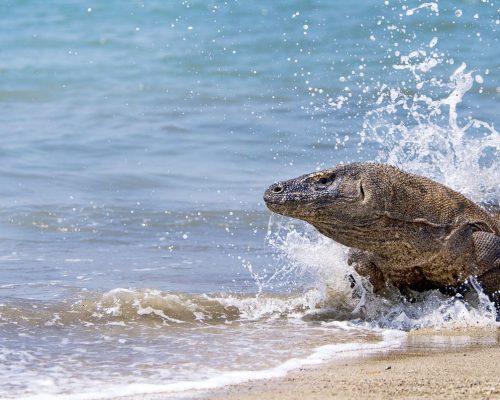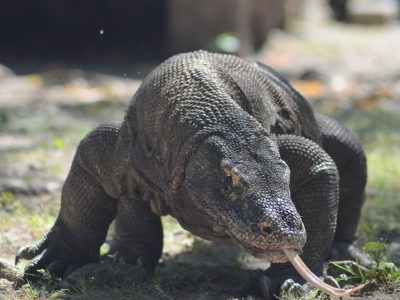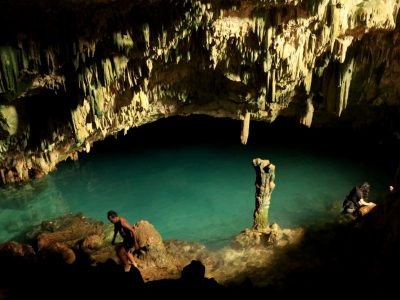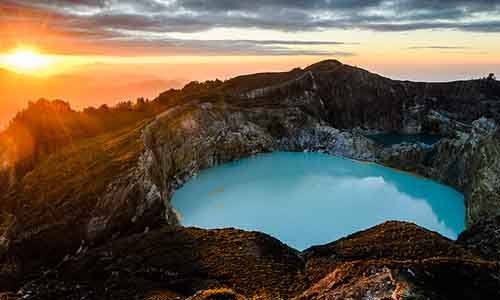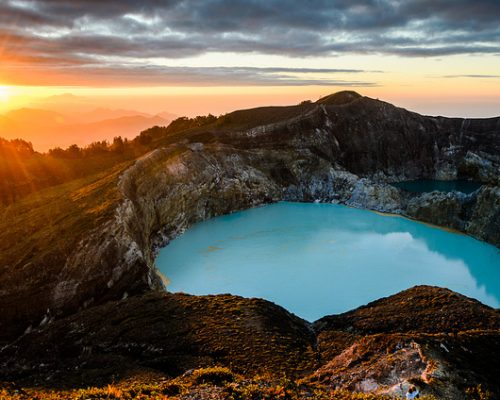Komodo National Park, located between Sumbawa and Flores, was founded in 1980 with the aim of protecting the endangered Komodo dragon. As the park is not only the last sanctuary for the Komodo dragon but also a unique area of marine biodiversity, it became a Man and Biosphere Reserve in 1986 and entered the list of UNESCO’s World Heritage Sites in 1991. With its outstanding submarine richness, it is not surprising that the park is one of the world’s finest destinations for scuba divers. With an area of 1,817 km², the park consists of Komodo Island, Rinca Island, Padar Island, and numerous smaller islands. The famous giant lizards, who are unique to Komodo National Park, are not only of great interest to tourists, but also to scientists studying the theory of evolution.
Inhabitants
Komodo National Park is home to about 3,500 people who live in four villages. The largest settlement is Komodo Village on Komodo Island; the other settlements are Rinca Village and Kerora Village on Rinca Island; and Paparagan Village on Paparagan Island. Most of the people in Komodo National Park make their living out of fishing. Some people earn extra income by carving wooden Komodo dragons to sell to visitors on Komodo Island, or at the airport and in hotels of Labuan Bajo.
When Komodo became a national park in 1980, these villages have already been in existence for about 70 years. The people’s origins can be drawn back to the Sultanate of Bima on Sumbawa Island. Life is not easy for them: as the population has grown massively over the years, they face serious shortages of water and firewood. Besides, pollution and over-fishing, using destructive methods such as dynamite fishing, has endangered marine life – the main source of livelihood and income of the Komodo inhabitants.
The Komodo dragon
The Komodo dragon (Varanus komodoensis) is the world’s largest and also one of the oldest living lizards. As already mentioned, it can only be found in the wild in Komodo National Park (more precisely on the islands of Komodo, Rinca, Nusa Kode, and Gili Motang) and to a minor extent on Flores’ west and north coasts. Adult dragons can reach a length of up to three meters, with an average weight of around 90kg.
Living mainly on carrion, the dragons also hunt deer and wild pigs, using their strong tail to bring the prey to the ground. Even though they appear rather inert, the dragons can accelerate up to 18 kilometers per hour while hunting. As they have an excellent sense of smell, they can locate their prey from a distance of several kilometers. Prey that is not killed immediately will die of blood poisoning because of the dragons’ septic saliva.
The Komodo dragon is a loner, living solitarily except at times of mating which usually takes place in the dry season between June and August. The female dragons bury their eggs and watch over them for a short time before leaving them to their fate. After nine months, the newly hatched baby dragons immediately climb up a tree to avoid the threat of being devoured by older dragons and other enemies. They live on small lizards and mammals, birds and their eggs, as well as insects. As soon as they get too heavy for tree dwelling, they have to go back to the ground to reach their final stage of adulthood.
An endangered species
The mystery of how the huge dragons found their way to Komodo and why they can only be found there is still not clear, herewith creating a fertile ground for unproven theories and assumptions. A popular theory suggests that periods of low sea levels enabled the dragons to reach Flores by land. As an assumed relic of extinct giant lizards, they only survived because of a lack of natural enemies in these islands’ isolated environment. With less than 2,500 lizards left, the Komodo dragon has now entered the International Union of Conservation of Nature’s (IUCN) red list of endangered species. The most threatening factor to survival is poachers who constantly minimize the population of the Timor deer, the Komodo dragon’s staple food.
Visiting the dragons
Komodo Island is the most-visited attraction of Flores. Rinca, a smaller island where the Komodo dragons can also be found, is a good alternative to crowded Komodo Island. There are innumerous tour operators both within and outside of Flores offering Komodo or Rinca tour packages. Many local guides and boat captains wait to take visitors there from Labuan Bajo.
Komodo National Park on the world stage
The Komodo National Park became one of the 28 official finalists in the ‘New 7 Wonders of Nature’ global campaign which was launched in 2007. ‘Vote Komodo’ was also taken on the international rally front by implementing creative activities around Europe to create awareness and to entice people to vote.
One day after the voting on November 12, 2011 it was announced that the Komodo National Park is one of the Seven New Wonders of Nature. Now, New7Wonders (www.new7wonders.com) plans to working with the Indonesian authorities and Komodo supporters to evolve a sustainable development strategy. The objective lays in balancing the needs of the Komodo habitat and its people with the vital task of defending the park’s ecological integrity.


